STORMS
Over the years we experience conditions that are excessive and downright scary. Many of you will remember storms that affected you directly.
Storms are generally a combination of high wind, heavy rain and perhaps lighting and thunder, but could also involve hail and snow. What is discussed below is mainly to do with wind.
We have got used to names being given to storms. Very useful when referring to them in the media. The Met Office tells us :
When is a storm named?
In the UK a storm will be named when it has the potential to cause disruption or damage which could result in an amber or red warning. This is based on our National Severe Weather Warnings service, which is a combination of both the impact the weather may have, and the likelihood of those impacts occurring.
Storms will usually be named on the basis of the impacts from strong winds, but the impacts of other weather types will also be considered. For example rain, if its impact could lead to flooding as advised by the Environment Agency, SEPA and Natural Resources Wales flood warnings, or snow. Therefore 'storm systems' could be named on the basis of impacts from the wind but also include the impacts of rain and snow.
How is a storm named?
When the criteria for naming a storm are met, either the Met Office, Met Éireann or KNMI can name a storm, taking the name from the latest list in alphabetical order.
We then let the public, our partners in government, the responder community and the media know through various routes including publishing details on our website and social media channels.
Some of them are from back in time, but others you may remember and even have your own stories about.
Some terminology:
A HURRICANE is a tropical storm with winds over 74mph.
A CYCLONE is a large storm that rotates around a low pressure system.
An EXTRATROPICAL CYCLONE is a large-scale low pressure weather system that forms in the middle latitudes of the earth, primarily drawing its energy from the temperature differences between air masses along weather fronts, unlike tropical cyclones which gain energy from warm waters; essentially its a mid-latitude storm system with associated cold fronts, warm fronts and occluded fronts, often producing significant precipitation and changing weather conditions.
An OCCLUDED FRONT is a weather front that forms when a cold front catches up with a warm front. The word “occluded” means “hidden”. [Wiki].
Eyemouth Disaster
14th October 1881
In Eyemouth, the morning of Friday 14 October 1881 is forever known as ‘Black Friday’ – the worst ever Scottish fishing disaster which left 189 lives lost to the sea. After weeks of bad weather, crews were desperate to get back to sea. On waking up to a clear and calm Friday morning, the fishermen chose to ignore the low reading on their barometer and set sail. Just when they began line fishing around midday, the entire country was blasted by a storm.
Many ships tried to sail home as quickly as possible but most either capsized or crashed into the Hurkar Rocks at the harbour entrance – the families of the sailors looked on, unable to help. Left behind were 93 wives, now widows and 267 fatherless children. One boat stumbled its way into the harbour hours later. The ‘Ariel Gazelle’ rode out the storm rather than rushing their way home – all crew members were safe.
HURRICAN LOW Q
1968
The 1968 storm which reeked absolute devastation and chaos on Scotland focused its destruction particularly on the City of Glasgow. It claimed 20 lives immediately – nine of which in Glasgow – and a further 30 lives of the men repairing the damage in the aftermath. Often denoted as ‘The Great Storm’ or Hurricane Low Q, the blast has been described as Central Scotland’s worst natural disaster since records began, leaving 2,000 Glaswegians homeless, 300 homes completely destroyed and a further 70,000 damaged.
In total, the gale affected 250,000 homes. Many families had to live with make-shift tarpaulin roofs for an abnormally long time whilst hospitals were asked to give mattresses to those who lost their homes and were forced to bed down in local schools. [Scottish Field].
THE BURNS DAY STORM
Burns Day 1990
There was no cause for celebration on Burns Day in 1990 as one of Europe’s strongest windstorms on record approached southern Scotland. Strong gusts of up to 104 mph were reported – which caused extensive damage. Subsequently, it was the country’s most expensive weather event to insurers – costing £3.37 billion. In the UK, a total of 97 deaths were reported, the fatality number is thought to be so high due to the storm occurring during the day, rather than at night when people would be asleep. The storm has since been deemed an example of when the Met Office ‘got the prediction right’ after observations from two ships in the Atlantic who were near the storm the day before it reached the UK. [Scottish Field].
BOXING DAY
Boxing Day 1998
Festivities came to an abrupt end on Boxing Day in 1998 when large parts of Scotland’s power went out. It’s thought that two million people were without electricity for at least 24 hours, with some homes not restored of power until the New Year. Gusts of 103 mph were recorded at Prestwick Airport whilst Hunterston B Nuclear Power Station was shut down when power was lost resulting in a level 2 on the International Nuclear Event Scale. This was due to safety measures not following through regarding the cooling of the reactors – but no lasting damage or injuries occurred. [Scottish Field]
HURRICANE BAWBAG (cyclone FrIedhein)
December 2011
This was an intense extratropical cyclone which brought hurricane force winds to Scotland including West Dunbartonshire.
The Cairngorms experienced its strongest gusts at 165mph.
West Dunbartonshire was badly hit with many trees affected.
CYCLONE ULLI
31st December 2011 into 2012
This was an intense European Windstorm originating as a cyclonic windstorm due to low atmospheric pressure. This one formed off New Jersey and gathered strength as it crossed the Atlantic.
Many of you will remember it as it felled trees across West Dunbartonshire and damaged buildings. While it was not as strong as that of the previous year, we still felt its full wrath and subsequent damage.
It was considered the costliest storm in places such as Glasgow where damage was very severe. It only dissipated on 7th January 2012. Its highest gust was felt in the Netherlands as 107mph.
STORM EOWYN
Friday the 24th January 2025
There was plenty of warning. A siren with a text message was sent by Government to all phone users within the UK the previous day. But the impact was far more ferocious than most of could imagine.
There was severe and widespread destruction across all of Northern Ireland and the central belt of Scotland with the rest of Scotland and the UK also experiencing a great deal of damage.
The most dramatic looking was the surf coming across the promenade in nearby Helensburgh and a great deal of the roof of the newly opened pool there being blown off. The railways were cancelled across Scotland.
Numerous trees came down and West Dunbartonshire experienced a high proportion of them. Some of these were very large and the roads had to be closed. The response from those who went in a cut them up with chainsaws and cleared them to the sides is highly commended. Similarly, several buildings within our area were damaged and needed heavy plant to clear. While the higher proportion involved flashings and slates, fences and signage etc, there were also some with very serious structural damage.
The worst of the wind abated a bit late in the afternoon. All schools and almost all shops had been closed, but a few such as fast food outlets were open. Towards the end of the day locals ventured out looking for warm food. This writer decided on such a quest and had to drive around cleared debris. He then came down Pier Road back to Balloch where a tree or large branch came crashing down onto his car smashing the windscreen, denting the roof in and wrecking the lights and a door. But he was a lucky one. Some people elsewhere lost their lives or were seriously injured,
Remember that damaged trees and structures can remain in place for a while, but may come crashing down after the main event.
Power was lost in many local areas as supply cables were damaged.
The Met Office notes Storm Éowyn developed through a process called explosive cyclogenesis This brought the UK's highest wind gust of the season so far on Friday with 100mph gusts at Drumalbin in South Lanarkshire. So we escaped the very worst of it, even though we still received a great deal of the impact.
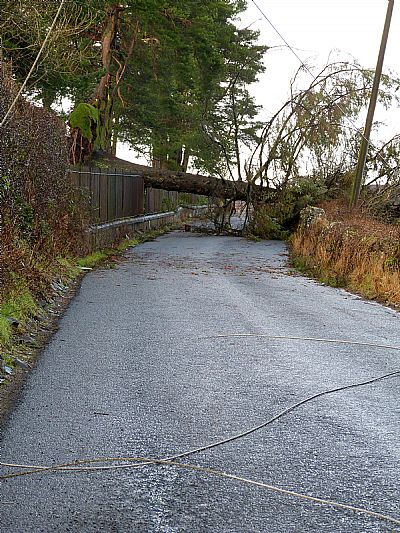
Here we see a large tree that fell across the fence of a private property on Cardross Road above Renton, bring down the power cables.
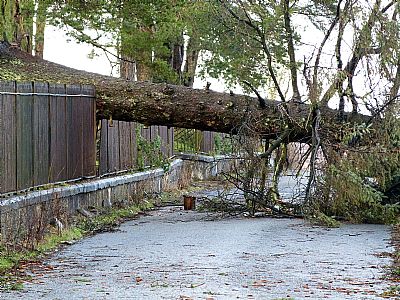
A closer view shows the size of the tree. Scottish Power found access difficult as the cables ran through the collapsed tree. And the Council found access difficult due to uncertainty about the safety of the downed cables. This and the next property were without power for over 4 days while it was sorted. At this time of year, inside temperatures can drop to just 6 degrees centigrade.
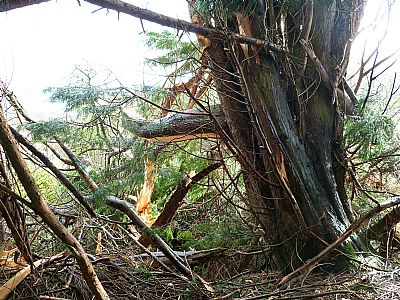
Different tree types behave in different ways. Large pine trees as in the previous picture may break or completely topple over when their roots loose grip with the soil. These mature cypress in a nearby garden split and crashed into pieces during the same high winds.
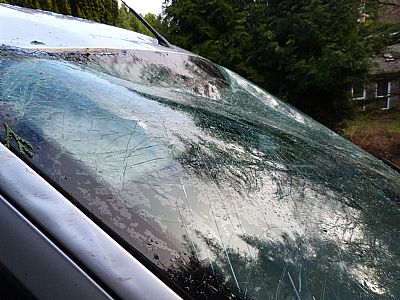
The driver of this car (who happens to be the writer of this piece) had a lucky escape when a tree or large branch crashed onto his car while driving. The high winds had already abated a bit when he ventured out, but presumably the tree in this case was already split when it gave way. The windscreen, the roof, a front light and side door were damaged.
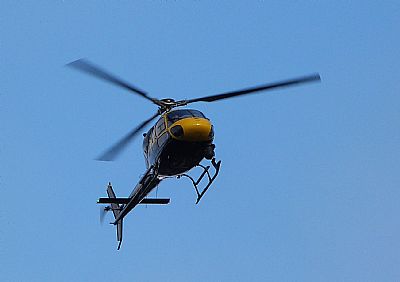
A helicopter surveys the widespread damage, this one focusing on the railway lines which ahd been affected. All rail travel had bee cancelled for a few days.
STORM AMY
The second significant storm of 2025. We are told that extreme weather events are on the increase and this seems to substantiate that.
Again West Dunbartonshire escapes the very worst of it and also has the beneftit of the topography ameliorating the impact. The UK Met Office has placed parts of the country under an Amber warning for strong winds. Gusts exceeding 120 km/h (75 mph) are likely in exposed coastal areas of Scotland and Northern Ireland, with disruption to transport, power lines, and structures expected. Offshore gusts may reach 150 km/h (93 mph), enhanced by sting jet dynamics within the storm system. [The Watchers].
While not as powerful as Storm Eowyn, the threat of damage is similar. What we have learnt is that trees and structures weakened by previous storms may then come down in a subsequent one. We need to remain very cautious.
MET OFFICE : https://www.metoffice.gov.uk/weather/warnings-and-advice/uk-storm-centre/index
and https://www.metoffice.gov.uk/blog/2025/a-look-back-on-storm-eowyn
WATCHERS : https://watchers.news/2025/10/02/storm-amy-rapidly-intensifying-near-ireland-uk/
WIKIPEDIA :
https://en.wikipedia.org/wiki/Hurricane_Bawbag

